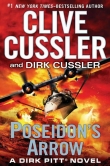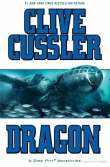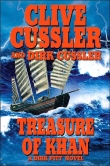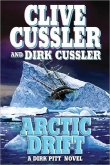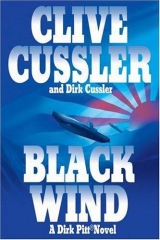
Текст книги "Black Wind"
Автор книги: Clive Cussler
Жанр:
Морские приключения
сообщить о нарушении
Текущая страница: 30 (всего у книги 35 страниц)
Ohlrogge noted the erector transporter had been returned to the hangar and that the hangar doors had been closed.
“We're talking minutes,” he said with alarm in his voice.
“About eighteen, to be precise. Captain, get your crew to the helipad now,” Pitt directed. “There's an airship waiting that can evacuate everyone from the platform if we move quick.”
Turning to Ohlrogge, Pitt added, “Is there any way we can stop the launch?”
“The launch sequence is completely automated and controlled by the assembly and command ship. Presumably, these terrorists have duplicated that functionality on their own vessel.”
“We can mechanically halt the fueling of the rocket,” Christiano noted.
“It is too late,” Ohlrogge said, shaking his head. “There is an override control in the bridge that would be our only hope at this late time,” he added grimly.
“The elevator at the rear of the hangar leads to the bridge deck. The helipad is just above,” Christiano said. “Then let's get moving,” Pitt replied.
Quickly, the group shuffled en masse to the rear of the hangar and crowded around a medium-sized elevator.
“There's not enough room for all,” Christiano stated, regaining his captain's form. “We'll need three trips. You eight men first, then this group, then you ten men over there,” he ordered, dividing the crowd into three groups.
“Jack, you go with the first group and help them onto the Icarus. Let Al know there's more on the way,” Pitt said. “Dirk, you bring up the last group, make sure everyone makes it out of here. Captain, we need to visit the bridge now,” he said, turning to Christiano.
Christiano, Ohlrogge, Dahlgren, and Pitt crowded into the elevator with eight other men and waited impatiently as the elevator zipped up to the bridge level above the hangar. Dahlgren quickly located a stairwell off to one side that led to the helipad and herded the crewmen up to the exposed deck.
As promised, the silver airship hung hovering several feet above the pad, Giordino at the controls smoking a fat cigar. He quickly rotated the swiveling propulsion ducts and brought the gondola down to the deck as Jack ran up.
“Hi, sailor. Give a few girls a ride?” Dahlgren asked, poking his head into the gondola doorway.
“Certainly,” Giordino replied. “How many do you have?”
“About thirty, give or take,” Dahlgren replied, looking suspiciously at the gondola's passenger compartment.
“Shove 'em in, we'll make them fit. But we better toss any unnecessary weight if we want to get off the ground. Just make it quick, as I have an aversion to getting baked alive.”
“You and me both, pardner,” Dahlgren replied, herding the first of the crewmen aboard.
In addition to the two-seat cockpit, the gondola's passenger compartment was configured to seat eight passengers in oversized leather airplane-type seats. Dahlgren studied the arrangement and grimaced at the prospect of squeezing all the men in and possibly grounding the blimp. As the crew climbed aboard, he checked the mountings of the seats and found that they had a quick-release mechanism for temporary removal. He quickly unlatched five of the seats and, with the help of a Russian engineer, tossed them out the door of the gondola.
“Everybody to the back of the bus,” he barked. “It's going to be standing room only.”
As the last man in his group wedged into the passenger compartment, Dahlgren turned to Al.
“How much time do we have?”
“About fifteen minutes, by my count.”
The next group of crewmen began spilling off the stairs and sprinting across the deck of the helipad. Dahlgren let out a slight sigh. There would be time, if not room, to get every man to the blimp before blastoff. But would it be enough time to stop the launch, he wondered, catching sight of the Zenit rocket standing fueled and ready across the platform.
Inside the Odyssey's bridge, Captain Christiano turned pale and shook his head silently as he surveyed the bullet-ridden computer stations and shattered glass that littered the floor. Walking to the navigation station, he curiously noticed a lonely computer mouse dangling by its cord, its companion keyboard nowhere to be seen. Ohlrogge observed that the computer drive itself was undamaged.
“I've got scores of laptop computers downstairs. We can plug one in and activate the platform controls,” he offered.
“They have no doubt secured the automated controls,” Christiano said with disgust, thrusting a thumb over his shoulder toward the window. Pitt followed his motion, observing the Koguryo sitting defiantly in the distance. Returning his gaze to the captain, Pitt caught sight of the Badger, still tied up in the water off the starboard support column far below.
“There is no time. It might take hours to work around,” Christiano continued, moving to the bridge's center console with a look of despair on his face.
“You said there was a manual override on the bridge?” Pitt asked.
Christiano anticipated the results before his eyes reached the console. They had simply known too much. How to navigate and ballast the platform, how to fuel the Zenit, how to control and launch the rocket from their own support ship. There was simply too much inside knowledge for the terrorists not to have sabotaged the manual override. With disappointing confidence in his beliefs, he looked down at a jumbled mass of cut wires and smashed controls that offered the last hope of halting the launch.
“Here's your manual override control,” he swore, flinging a segregated clump of wires and switches across the bridge. The three men stood in silence as the mass of electronics bounced across the deck before coming to a halt against the bulkhead. Then the bridge door opened and Dirk thrust his head into the bay. From the looks on the other men's faces, he knew that their attempt to prevent the launch had failed.
“The crew is all aboard the airship. I respectfully suggest we abandon the platform, and now.”
As the last four men aboard the platform began to scramble up the helipad stairwell to the waiting airship, Pitt stopped and grabbed his son by the shoulder.
“Get the captain aboard the blimp and tell Al to take off without me. Make sure he gets the airship up range of the platform before the rocket fires.”
“But they said there was no getting around the automated launch controls,” the younger Pitt protested.
“I may not be able to stop the rocket from launching, but I just might be able to change its destination.”
“Dad, you can't stay aboard the platform, it's too dangerous.”
“Don't worry about me, I don't intend to stick around,” Pitt replied, giving his son a gentle shove. “Now get going.”
Dirk looked his father in the eye. He had heard numerous tales of his father placing the safety of others above himself and now he was seeing it firsthand. But there was something else in his eyes. It was a calm look of assurance. Dirk took a step toward the stairwell, then turned back to wish his father luck but he had already vanished down the elevator.
Sprinting up the stairwell two steps at a time, the younger Pitt leaped onto the deck of the helipad and looked on in amazement at the waiting blimp. The gondola looked like a windowed can of sardines, with the fish replaced by humans. The entire Sea Launch crew had managed to squeeze aboard the passenger compartment, cramming into every available square inch. The weakest of the crew were given the three passenger seats that Dahlgren did not remove while the rest of the men stood shoulder to shoulder in the remaining space. Scores of men hung their heads out the side windows while one or two were even jammed into the small bathroom at the rear of the gondola. The sight made a New York City subway at rush hour look spacious by comparison.
Dirk ran over and wedged himself through the door, hearing Dahlgren's voice somewhere in the mass telling him that the copilot's seat was vacant. Half-crawling, he squirmed his way into the cockpit, taking the empty seat alongside Giordino, who had moved to the left-hand pilot's seat.
“Where's your dad? We need to get off this barbecue grill, pronto.”
“He's staying put. Has one last trick up his sleeve, I guess. He said to get the blimp up range of the platform, and that he'll meet you for a tequila on the rocks after the show.”
“I hope he's buying,” Giordino replied, then tilted the propeller ducts to a forty-degree angle and boosted the throttles. The gondola chugged forward, pulling the helium-filled envelope with it. But in stead of rising gracefully into the air as before, the gondola clung to the deck, dragging across the helipad with a dull scraping sound.
“We've got too much weight,” Dirk stated.
“Get up, baby, get up,” Giordino urged the mammoth airship.
The gondola continued to skid across the pad, heading to the forward edge, which dropped straight down two hundred feet to the sea. As they approached the lip of the helipad, Giordino adjusted the propellers to a higher degree of inclination and jammed the throttles to their stops but the gondola continued to scrape along the deck. An eerie silence filled the cabin, as every man held his breath while the gondola slipped over the edge of the helipad.
A falling surge suddenly hit the pit of everyone's stomach as the gondola lurched down ten feet, then halted. The occupants were roughly thrown forward as the blimp's fabric-covered tail bounced off the helipad, pushing the nose of the blimp at a steep decline as the airship's balance of weight cleared the edge. Continuing to jar forward, the tail finally scraped past the platform edge and the entire blimp rushed nose first toward the sea.
Giordino had a split-second decision to make in order to save the airship. He could either pull the thrusters all the way back to a ninety-degree vector and hope the engine propulsion would overcome the excess weight and hold the blimp at altitude. Or he could do the complete reverse: by pushing down the thrusters, he could try to increase the blimp's forward velocity, which would generate lift if he gained sufficient speed. Staring at the looming ocean, he let the momentum of the blimp guide his decision and calmly pushed the yoke forward, accelerating their downward dive.
Cries of alarm wafted from the rear passengers as it appeared Giordino was deliberately trying to crash into the sea. Ignoring the pleas, he turned to Dirk in the copilot's seat.
“Above your head there is a water ballast release control. At my command, hit the release.”
While Dirk located the button on the overhead console, Giordino focused his eyes on the altimeter. The dial was rolling backward quickly from two hundred feet as their descent speed increased. Giordino hesitated until the dial read sixty feet, then barked: “Now!”
In unison, Giordino yanked back on the yoke while Dirk activatec the water ballast system, which instantly dumped a thousand pounds of water stored in a compartment beneath the gondola. Despite the sudden actions, there was no immediate response from the blimp. The massive airship moved at its own deliberate pace, and, for an instant Giordino thought he had acted too late. As the approaching ocean filled the view out the cockpit windshield in a rush of speed, the nose gently began to pull up in a sweeping arc. Giordino eased of the yoke to level the airship as the gondola surged closer toward the sea, its nose rising with agonizing slowness. With a sudden jolt, the base of the gondola slapped the water's surface as the airship flattened from out of its dive but bounded quickly up and off the surface. As every man aboard held his breath, the blimp staggered forward a short distance before slowly climbing a few feet above the water and holding steady. As the seconds ticked by and the airship held in the air, in became apparent that Giordino had pulled it off. Though risking high-speed impact, the accelerated dive and last-second ballast release had been just enough to keep them airborne.
The relieved men in the passenger compartment let out a cheer as Giordino gingerly coaxed the blimp up to an altitude of one hundred feet, the big airship slowly stabilizing under his steady hand.
“I guess you showed us who's master of the airship,” Dirk laudedl “Yeah, and almost commander of a submarine,” Giordino replied as he eased the nose of the blimp to the east and away from the platform.
“Uprange and away from shore isn't exactly the direction I'd like to be going at this altitude,” he added, eyeing the Koguryo warily out the window to port. “I radioed Deep Endeavor to get out of the way of the rocket's flight path, so they should be cutting a wide swath around to the north. We ought to keep them in sight in case we have to ditch.”
Dirk scanned the horizon, keeping one eye locked on the launch platform. Far to the southwest, he spotted the distant mass of San Nicolas Island. Peering to the northeast, he saw a tiny blue dot, which he knew to be the Deep Endeavor. Then, just to the north of the NUMA ship, he noticed a small brown mass rising from the sea.
“That landmass up ahead. I recall from the navigation charts that it's a small channel island called ”Santa Barbara.“ Why don't we head that way? We can drop the crew there and have Deep Endeavor pick them up before we get into any more trouble.”
“And get back to find your dad,” Giordino said, finishing Dirk's thought. Dirk looked back at the platform with hesitation.
“Can't be much time left,” he muttered.
“About ten minutes,” Giordino replied, wondering like Dirk what Pitt could possibly pull off in such little time.
Physically surviving A launch on board the Odyssey was not impossible. When a rocket was fired, the main thrust was directed beneath the platform at ignition. The Odyssey had been constructed as a reusable launch platform, and, in fact, had already withstood more than a dozen launches. The deck, hangar, crew compartment, and pilothouse were all built to withstand the fiery heat and exhaust generated from a powerful rocket launch. What a human inhabitant was not likely to survive, however, was the noxious fumes that engulfed the platform at blastoff. A massive billow of exhaust from the spent kerosene and liquid oxygen fuel all but buried the Odyssey in a thick cloud of smoke for several minutes after liftoff, smothering the breathable air in the vicinity of the platform.
But that was of little concern to Pitt as he jumped off the elevator and raced out a back door of the hangar. He had no interest in hanging around the platform when the Zenit was lit off. Instead, he was hell-bent on making it to the bright red submersible he saw bobbing in the water from the pilothouse window. Like a contestant running a timed obstacle course, Pitt ran, jumped, and hurdled his way across the platform to the corner column support and sprinted down the steps to the water's edge. In their haste to evacuate the platform, Tongju and his men had not thought it necessary to let adrift the NUMA sub. Pitt was thankful to find her still tied to the column steps as he exhaustedly reached the water's edge.
Untying the line, he jumped aboard and scrambled down the Badger's top hatch, sealing it closed behind him. In seconds, he had activated the submersible's power systems and opened the ballast tank for submersion. Engaging the throttles, he quickly maneuvered away from the Odyssey's forward column and proceeded down the interior length of the platform before positioning the submersible for the task at hand. Holding the submersible steady, Pitt activated the controls to the bow-mounted coring device and, with just minutes to spare, prayed that his cockamamie plan would work.
The Korean launch team aboard the Koguryo watched the video screen with curiosity as the silver blimp touched down on the Odyssey's helipad and the crew of the platform jammed into the gondola. Kim grimaced with anger but noted that Tongju remained calm.
“We should have killed the crew and destroyed that airship when we had the opportunity,” Kim hissed as they watched the Icarus lurch off the platform. An alternate camera was turned toward the blimp, showing the airship fight for altitude before turning out to sea. Tongju nodded toward the video image with assurance.
“She is overloaded and unable to make speed. We shall easily catch and destroy her after the launch,” he said quietly to Kim.
His eyes returned to the launch countdown and the noisy jabber of the engineers within the control center. The room was a flurry of activity and pressure as the final minutes drew to a close. Ling stood nearby, reviewing the output from a series of launch vehicle assessments. Beads of sweat rolled from his forehead in tense anticipation despite the cool temperature of the air-conditioned bay.
For Ling, there was every reason to be nervous. In the world of space vehicle delivery, there was an astounding rate of mortality. He knew all too well that roughly one in ten satellite launches ended in failure, and that the fault could come from a thousand and one sources. Failure of the rocket at launch was still not an uncommon occurrence, though most satellite losses were due to deploying the payload in an incorrect orbit. The short, suborbital flight of the mission at hand eliminated a great deal of the problematic issues associated with most rocket flights, but the risk of a catastrophic launch failure never went away.
Ling breathed easier as he digested the latest status updates. All critical systems appeared operational. There was nothing to indicate that the trustworthy Zenit rocket would not fire off in its usual dependable manner. With less than five minutes to go, he turned to Tongju and spoke with a glimmer of confidence.
“There will be no launch holds. The countdown will proceed unimpeded.”
Their attention turned to the image of the rocket on the video screen in its last minutes before takeoff. Despite the multitude of studious eyes converged on the image of the rocket and platform, no one in the room noticed the tiny movement at the periphery of the picture. Only the camera saw as a dark-haired man ran to the edge of the platform and scrambled out of sight down the corner column stairwell.
Pitt had wasted no time in engaging the full set of thrusters that powered the Badger. Though he knew it was the worst possible place to be, he quickly guided the submersible down the underbelly length of the platform and maneuvered the vehicle to a stop alongside the rear starboard support column. Directly above him was the recessed launchpad flame deflector, which would route the titanic blast of the Zenit's thrust toward the sea at liftoff.
Pitt turned the nose of the submersible until it was aimed at the column, then backed away from the rotund support leg as he submerged the vessel to a depth of fifteen feet. Using a set of manipulator controls, he lowered the huge coring probe until it stretched perfectly horizontal in front of the submarine's prow, protruding like a medieval jousting lance. Pitt braced his feet against the metal deck plate and muttered, “Okay, Badger, let's see your bite,” as he jammed the throttles to full forward.
The shiny red submersible clawed its way through the water, quickly gaining speed over the short distance to the column. Pushed by the full weight and force of the submersible, the coring probe slammed into the side of the massive steel column with a bang. Pitt held his breath as he was jolted forward and continued to slide ahead until the nose of the submersible slapped against the column. Rammed to a halt, he quickly threw the thrusters in reverse and peered through the surging bubbles as the submersible backed away from the column. A metallic grating sound echoed back at him as the probe was drawn roughly off the column. Through the murky and turbulent water, he caught a glimpse of the coring probe jutting intact off the bow and he exhaled in relief. As Pitt had hoped, the momentum of the speedy submersible had driven the tip of the coring probe cleanly through the side of the support column, opening an eight-inch-diameter hole.
Pitt felt a little like Ezra Lee on the Turtle. The Revolutionary War volunteer had attempted to sink a British warship in David Bushnell's small wooden submarine by drilling a hole in the side and attaching a mine. Though the attempt failed, the Turtle would be remembered in history as the first submarine ever used in combat. With the benefit of propulsion, Pitt backed the Badger away twenty feet and adjusted his depth slightly, then reversed the thrusters and charged into the column again. Once more, the probe tore through the outer wall of the column, leaving a neat round hole for the seawater to pour into.
Though abjectly crude, Pitt's mad ploy had an element of simple genius to it. He calculated that if there was no way to stop the rocket from lifting off, then, perhaps, there was a way to change its intended destination. By creating an imbalance in the platform, he might at least angle the rocket off its intended flight path. On such a short flight, the rocket's guidance system would not have sufficient time to fully correct the deviation and could miss its intended target by miles. And there was no doubt that the Achilles' heel of the platform at launch were the rear support columns. With the rocket standing vertically at the extreme rear edge of the platform, the Odyssey had to maintain a careful balance to handle the uneven weight distribution across the entire platform. An active trim-and-heel system utilized ballast tanks in the columns and pontoons to maintain stability, managed by six large ballast pumps. By flooding the rear support columns, there was a chance of destabilizing the launch deck. For Pitt, it would be a desperate race against the ballast pumps to create a material imbalance.




